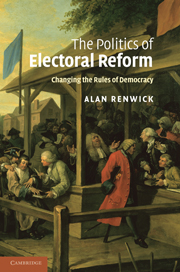Book contents
- Frontmatter
- Contents
- List of tables
- List of figures
- List of abbreviations
- Acknowledgements
- 1 Introduction
- PART I Building blocks
- PART II Elite majority imposition
- PART III Elite–mass interaction
- 9 Italy: diluting proportional representation
- 10 Japan: the abandonment of SNTV
- 11 New Zealand: MMP in a Westminster setting
- 12 Elite–mass interaction: comparative analysis
- 13 Conclusions and implications
- Appendix: glossary of electoral system terminology
- Bibliography
- Index
9 - Italy: diluting proportional representation
Published online by Cambridge University Press: 04 May 2010
- Frontmatter
- Contents
- List of tables
- List of figures
- List of abbreviations
- Acknowledgements
- 1 Introduction
- PART I Building blocks
- PART II Elite majority imposition
- PART III Elite–mass interaction
- 9 Italy: diluting proportional representation
- 10 Japan: the abandonment of SNTV
- 11 New Zealand: MMP in a Westminster setting
- 12 Elite–mass interaction: comparative analysis
- 13 Conclusions and implications
- Appendix: glossary of electoral system terminology
- Bibliography
- Index
Summary
The story of electoral reform in Italy that I told in Chapter 6 was incomplete: it left out the most significant of all of post-war Italy's reform episodes. In 1993, Italy became the first (and, to date, only) established democracy to replace a proportional electoral system with one based primarily upon single-member plurality (SMP). More precisely, the new law described a semi-compensatory mixed-member system, or, in Shugart and Wattenberg's terms, a mixed-member majoritarian (MMM) system with partial compensation (2001b: 15–16). Seventy-five per cent of seats were allocated by SMP and 25 per cent by PR. Though this distribution would generally be sufficient to provide full proportionality, linkage between the tiers was based on votes rather than seats, and it is for this reason that the system is classified as MMM with partial compensation rather than full mixed-member proportional (MMP). Somewhat different variants of this model were used in the two chambers. For the lower house (Chamber of Deputies), voters cast two votes. PR seats were allocated nationally subject to a 4 per cent threshold using largest remainders after deducting from each party's vote total the number of votes that had been required for victory by that party's winning district candidates (that is, after deducting, for each single-member district (SMD) in which the party's candidate had won, the number of votes won by the second-placed candidate plus one). In the Senate, voters cast just one vote, for an SMD candidate, which was valid also for the party's PR list.
- Type
- Chapter
- Information
- The Politics of Electoral ReformChanging the Rules of Democracy, pp. 169 - 178Publisher: Cambridge University PressPrint publication year: 2010



